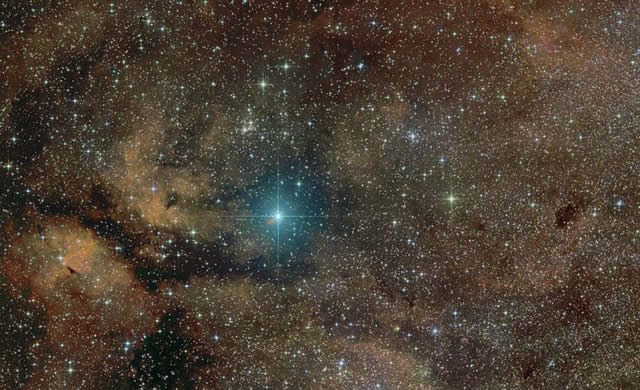
Image Credit & Copyright: Jose Francisco Hernandez (Altamira Observatory)
La Stella supergigante Gamma Cygni si trova al centro della Croce del Nord, il famoso asterismo che si trova nella costellazione del Cigno (Cygnus).
Conosciuta come Sadr, la luminosissima stella si trova al centro di questo splendido quadro stellare, composto da un complesso di stelle, nubi di polvere e nebulose incandescenti, lungo il piano della nostra Via Lattea. Il campo visivo si estende su oltre 3 gradi (sei pleniluni) sul cielo e comprende le emissioni della nebulosa IC 1318 e dell’ammasso stellare aperto NGC 6910. A sinistra di Gamma Cygni la forma di due ali cosmiche incandescenti divise da una lunga striscia di polvere scura, nota con il nome popolare di IC 1318 o Nebulosa Farfalla. Sopra e leggermente a sinistra di Gamma Cygni, si trovano giovani stelle strettamente raggruppate in NGC 6910. La distanza stimata per Gamma Cygni è di circa 750 anni luce, mentre le stime per IC 1318 e NGC 6910 vanno da 2.000 a 5.000 anni luce.
Supergiant star Gamma Cygni lies at the center of the Northern Cross, a famous asterism in the constellation of the Swan (Cygnus).
Known by the proper name Sadr, the bright star also lies at the center of this gorgeous skyscape, featuring a complex of stars, dust clouds, and glowing nebulae along the plane of our Milky Way galaxy. The field of view spans over 3 degrees (six Full Moons) on the sky and includes emission nebula IC 1318 and open star cluster NGC 6910. Left of Gamma Cygni and shaped like two glowing cosmic wings divided by a long dark dust lane, IC 1318’s popular name is understandably the Butterfly Nebula. Above and slightly left of Gamma Cygni, are the young, still tightly grouped stars of NGC 6910. Some distance estimates for Gamma Cygni place it at around 750 light-years while estimates for IC 1318 and NGC 6910 range from 2,000 to 5,000 light-years.
Source/Continue reading → Apod.NASA.gov

















